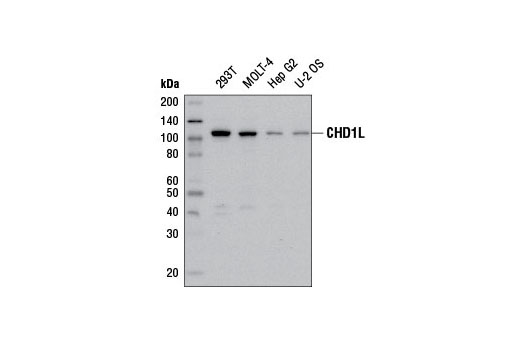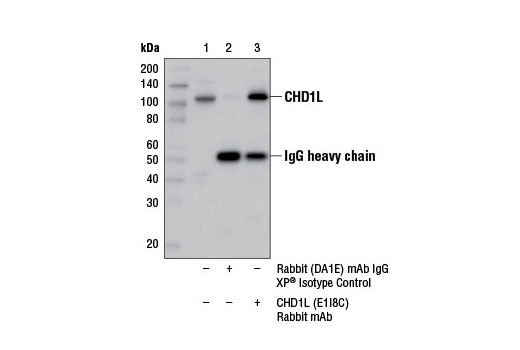WB, IP
H
Endogenous
110
Rabbit IgG
#Q86WJ1
9557
Product Information
Product Usage Information
| Application | Dilution |
|---|---|
| Western Blotting | 1:1000 |
| Immunoprecipitation | 1:100 |
Storage
Specificity / Sensitivity
Species Reactivity:
Human
Source / Purification
Monoclonal antibody is produced by immunizing animals with a synthetic peptide corresponding to residues surrounding Gly231 of human CHD1L protein.
Background
Chromodomain-helicase-DNA-binding domain 1 like (CHD1L) is a DNA helicase and member of the SNF2 subfamily of ATP dependent chromatin remodeling enzymes (1). Unlike other CHD chromatin remodeling proteins, CHD1L lacks a methylated histone binding chromodomain but does contain a macro domain that binds poly-ADP ribosylated (PARylated) targets (1,2). Following genotoxic stress, CHD1L interacts with PARylated PARP1 and is recruited to sites of DNA damage to facilitate DNA repair (3,4). The CHD1L protein is often over expressed in metastatic hepatocellular carcinoma (HCC) and the corresponding CHD1L gene is located in a region that is frequently amplified in cases of HCC (5-7). Research studies indicate that CHD1L over expression may lead to over relaxation of chromatin and exposing the underlying DNA to genotoxic stress (1). CHD1L can regulate expression of genes that promote tumor cell proliferation, migration and metastasis, providing another mechanism where CHD1L may promote hepatocellular carcinoma progression and metastasis (6,8). Additional research studies suggest that over expression of CHD1L may be involved in the progression of bladder, colon and ovary cancer (9-11).
- Deng, W. (2009) Cell Stem Cell 5, 349-50.
- Karras, G.I. et al. (2005) EMBO J 24, 1911-20.
- Gottschalk, A.J. et al. (2009) Proc Natl Acad Sci U S A 106, 13770-4.
- Ahel, D. et al. (2009) Science 325, 1240-3.
- Ma, N.F. et al. (2008) Hepatology 47, 503-10.
- Chen, L. et al. (2010) J Clin Invest 120, 1178-91.
- Chen, L. et al. (2009) Hepatology 50, 122-9.
- Chen, M. et al. (2009) PLoS One 4, e6727.
- He, W.P. et al. (2012) BMC Cancer 12, 437.
- Ji, X. et al. (2013) J Surg Res 185, 84-91.
- Tian, F. et al. (2013) Tumour Biol , [Epub ahead of print].
Species Reactivity
Species reactivity is determined by testing in at least one approved application (e.g., western blot).
Western Blot Buffer
IMPORTANT: For western blots, incubate membrane with diluted primary antibody in 5% w/v nonfat dry milk, 1X TBS, 0.1% Tween® 20 at 4°C with gentle shaking, overnight.
Applications Key
WB: Western Blotting IP: Immunoprecipitation
Cross-Reactivity Key
H: human M: mouse R: rat Hm: hamster Mk: monkey Vir: virus Mi: mink C: chicken Dm: D. melanogaster X: Xenopus Z: zebrafish B: bovine Dg: dog Pg: pig Sc: S. cerevisiae Ce: C. elegans Hr: horse GP: Guinea Pig Rab: rabbit All: all species expected
Trademarks and Patents
Limited Uses
Except as otherwise expressly agreed in a writing signed by a legally authorized representative of CST, the following terms apply to Products provided by CST, its affiliates or its distributors. Any Customer's terms and conditions that are in addition to, or different from, those contained herein, unless separately accepted in writing by a legally authorized representative of CST, are rejected and are of no force or effect.
Products are labeled with For Research Use Only or a similar labeling statement and have not been approved, cleared, or licensed by the FDA or other regulatory foreign or domestic entity, for any purpose. Customer shall not use any Product for any diagnostic or therapeutic purpose, or otherwise in any manner that conflicts with its labeling statement. Products sold or licensed by CST are provided for Customer as the end-user and solely for research and development uses. Any use of Product for diagnostic, prophylactic or therapeutic purposes, or any purchase of Product for resale (alone or as a component) or other commercial purpose, requires a separate license from CST. Customer shall (a) not sell, license, loan, donate or otherwise transfer or make available any Product to any third party, whether alone or in combination with other materials, or use the Products to manufacture any commercial products, (b) not copy, modify, reverse engineer, decompile, disassemble or otherwise attempt to discover the underlying structure or technology of the Products, or use the Products for the purpose of developing any products or services that would compete with CST products or services, (c) not alter or remove from the Products any trademarks, trade names, logos, patent or copyright notices or markings, (d) use the Products solely in accordance with CST Product Terms of Sale and any applicable documentation, and (e) comply with any license, terms of service or similar agreement with respect to any third party products or services used by Customer in connection with the Products.

